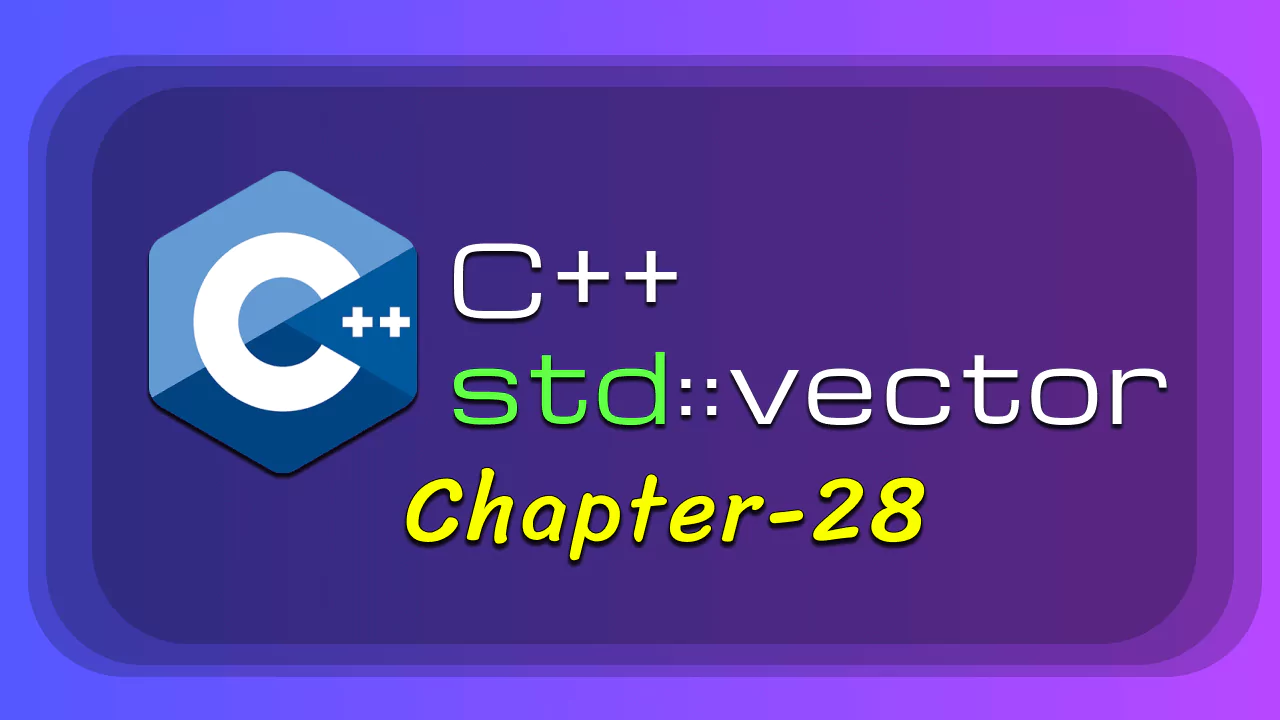std::vector | Vector in C++
Posted on August 8, 2025 • 4 minutes • 819 words
In C++, std::vector is a dynamic array provided by the Standard Template Library (STL).
Unlike traditional arrays with fixed size, a vector can grow or shrink at runtime, making it one of the most widely used containers in modern C++ programming.

Key Points:
-
Stores elements contiguously in memory (like arrays).
-
Automatically manages memory allocation.
-
Offers random access to elements in O(1) time.
-
Provides built-in functions for insertion, deletion, and iteration.
Basic Declaration and Initialization
#include <iostream>
#include <vector>
int main()
{
// empty vector of integers
std::vector<int> numbers;
// vector with 5 elements (default-initialized to 0)
std::vector<int> nums(5);
// vector with 5 elements, each 10
std::vector<int> values(5, 10);
// initializer list
std::vector<int> copy = {1, 2, 3, 4};
return 0;
}
Adding and Removing Elements
push_back() – Adds an element at the end
vector<int> v;
v.push_back(10);
v.push_back(20);
pop_back() – Removes the last element
v.pop_back();
insert() – Inserts at a specific position
// insert 15 at index 1
v.insert(v.begin() + 1, 15);
erase() – Removes elements from a specific position or range
// remove first element
v.erase(v.begin());
// remove first 2 elements
v.erase(v.begin(), v.begin() + 2);
clear() – Removes all elements
v.clear();
Accessing Elements
vector<int> v = {10, 20, 30};
// direct access (no bounds checking)
cout << v[0] << endl;
// safe access (throws exception if out of range)
cout << v.at(1) << endl;
// first element
cout << v.front() << endl;
// last element
cout << v.back() << endl;
Iterating Over a Vector
Using a for loop
for (size_t i = 0; i < v.size(); i++)
cout << v[i] << " ";
Using a range-based for loop
for (int x : v)
cout << x << " ";
Using iterators
for (auto it = v.begin(); it != v.end(); ++it)
cout << *it << " ";
Capacity Functions
vector<int> v = {1, 2, 3};
cout << "Size: " << v.size() << endl;
cout << "Capacity: " << v.capacity() << endl;
// preallocate space
v.reserve(10);
cout << "New capacity: " << v.capacity() << endl;
// reduce capacity to match size
v.shrink_to_fit();
Resizing a Vector
vector<int> v = {1, 2, 3};
// adds 2 elements with default value 0
v.resize(5);
// removes last 3 elements
v.resize(2);
Vector of Custom Objects
struct Person
{
string name;
int age;
};
vector<Person> people = {{"ANOOP", 25}, {"VINEETH", 22}};
people.push_back({"SIDHARTH", 23});
Performance Tips
- Use reserve() when you know the expected size to avoid repeated reallocations.
- Access with [] for speed, but use .at() when you need bounds checking.
- Prefer emplace_back() over push_back() when creating objects.
struct Point
{
Point(int a, int b) : x(a), y(b) {}
int x, y;
};
vector<Point> points;
// constructs directly in place
points.emplace_back(1, 2);
std::vector is one of the most powerful and versatile containers in C++.
It offers the convenience of dynamic sizing, safety with .at(), and high performance with contiguous memory storage.
If you’re starting with STL, mastering std::vector is the perfect first step.
Complete Example
#include <iostream>
#include <vector>
int main()
{
std::vector<int> nums;
for (int i = 1; i <= 5; i++)
nums.push_back(i * 10);
std::cout << "Numbers: ";
for (int n : nums)
std::cout << n << " ";
std::cout << std::endl;
nums.insert(nums.begin() + 2, 25);
nums.erase(nums.begin());
std::cout << "After modifications: ";
for (int n : nums)
std::cout << n << " ";
std::cout << std::endl;
return 0;
}
std::vector Cheat Sheet – C++
| Category | Function / Syntax | Description |
|---|---|---|
| Syntax | std::vector<T> v; |
Empty vector |
std::vector<T> v(size); |
Vector with size elements |
|
std::vector<T> v(size, value); |
Vector with elements initialized to value |
|
std::vector<T> v = {val1, val2}; |
Initialize with list | |
| Add / Remove | v.push_back(value); |
Add element at end |
v.pop_back(); |
Remove last element | |
v.insert(iter, value); |
Insert element at position | |
v.erase(iter); |
Remove element at position | |
v.erase(start, end); |
Remove range of elements | |
v.clear(); |
Remove all elements | |
| Access | v[index] |
Direct access (no bounds check) |
v.at(index) |
Safe access (bounds check) | |
v.front() |
First element | |
v.back() |
Last element | |
| Capacity | v.size() |
Number of elements |
v.capacity() |
Allocated storage | |
v.empty() |
Check if vector is empty | |
v.reserve(n) |
Preallocate storage | |
v.shrink_to_fit() |
Reduce capacity to size | |
v.resize(count) |
Change number of elements | |
| Iteration | for (size_t i = 0; i < v.size(); i++) |
Loop by index |
for (auto x : v) |
Range-based loop | |
for (auto it = v.begin(); it != v.end(); ++it) |
Iterator loop | |
| Performance Tips | Use reserve() |
Avoids multiple allocations |
Use emplace_back() |
Constructs in place | |
Prefer [] over .at() |
Faster (no bounds check) | |
| Avoid middle insertions | Consider std::list/std::deque |

